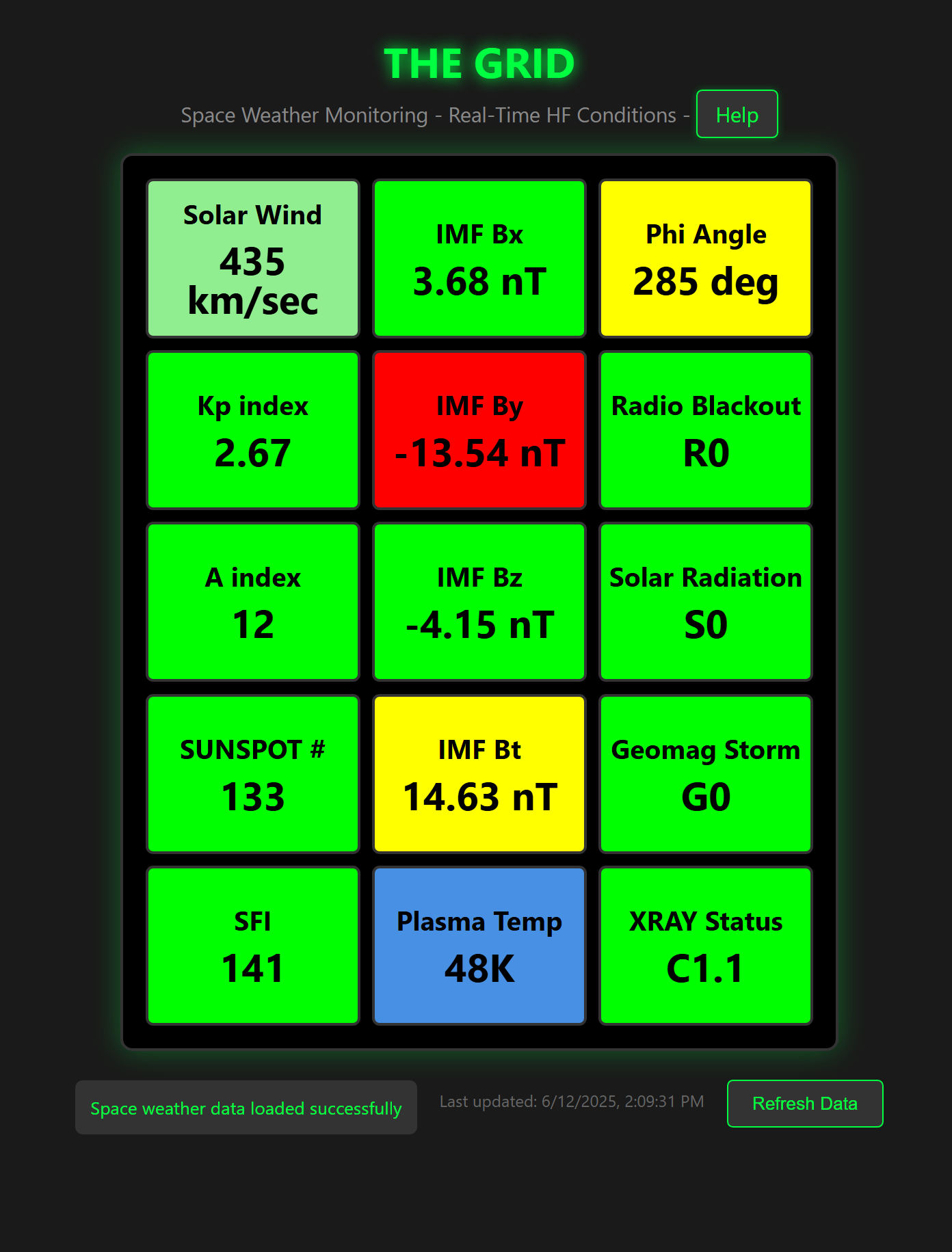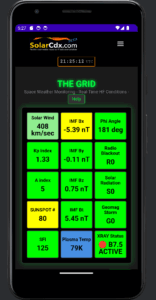Your Essential Companion for Portable Ham Radio Operations
As a ham radio operator venturing into the field for portable operations, you know that success depends on understanding propagation conditions. Whether you’re activating a rare summit for SOTA, participating in Field Day, or operating from a remote beach location, having real-time space weather data at your fingertips can make the difference between making contacts and missing opportunities entirely.
Why Space Weather Matters for Portable Operations
During portable operations, you’re often working with limited power, compromised antennas, and challenging environments.
Unlike your home station where you might have multiple backup options and higher power to overcome poor conditions, portable work demands precision. Understanding current solar conditions helps you:
- Choose the right bands at the right times – No point calling CQ on 20 meters during an X-class flare
- Maximize your limited power – Work with propagation instead of fighting it
- Plan your operating schedule – Know when conditions favor your target regions
- Avoid frustrating dead periods – Understand why the bands seem lifeless
Enter The Grid©: Real-Time Space Weather in Your Pocket
The Grid© feature on SolarCdx.com transforms your smartphone into a powerful space weather monitoring station. This compact, mobile-optimized display presents 15 critical space weather parameters in an instantly readable format designed specifically for ham radio operators.
What The Grid Shows You
The Grid presents a comprehensive view of current conditions through color-coded cells displaying:
Solar Activity Indicators:
- 10.7cm Solar Flux Index (SFI) – The foundation of HF propagation prediction
- Sunspot Number – Current solar activity level
- X-ray Flare Status – Real-time flare activity that can cause immediate blackouts
Geomagnetic Conditions:
- Kp Index – Planetary geomagnetic activity level
- A Index – Geomagnetic storm intensity
- Geomagnetic Storm Level (G0-G5) – NOAA scale storm classification
Interplanetary Magnetic Field (IMF):
- IMF Bx, By, Bz, and Bt – Magnetic field components affecting geomagnetic activity
- Phi Angle – IMF sector structure affecting propagation patterns
Solar Wind Parameters:
- Solar Wind Speed – Affects geomagnetic disturbance potential
- Plasma Temperature – Indicates solar wind structure
Current Disturbances:
- Radio Blackout Level (R0-R5) – Current HF blackout conditions
- Solar Radiation Storm Level (S0-S5) – Energetic particle effects
The Power of Instant Assessment
Each parameter uses intuitive color coding:
- Green indicates conditions favorable for HF propagation
- Yellow shows marginal conditions requiring careful band selection
- Orange warns of degraded propagation
- Red signals poor conditions or active disturbances
This visual system allows you to assess overall conditions at a glance, even in bright sunlight or challenging field conditions.
Deep Dive Information at Your Fingertips
Here’s where The Grid truly excels for portable operations: every cell is clickable. When you need to understand not just current conditions but how long they’ll persist, simply tap any parameter for detailed information. Each click takes you to comprehensive real-time data including:
- Historical trends – See how conditions have been developing
- Duration forecasts – Understand when disturbances will end or good conditions will deteriorate
- Detailed explanations – Learn exactly how each parameter affects your specific bands
- Future predictions – Plan your operating schedule around expected changes
Critical Planning Intelligence
This clickable functionality transforms The Grid from a simple status display into a powerful planning tool. For example:
- Tap the Kp Index during elevated activity to see storm duration forecasts
- Click Solar Wind Speed to understand if high-speed streams will continue
- Select X-ray Status during flare activity to see blackout duration estimates
- Check SFI trends to determine if improving conditions will persist
This detailed backing information helps you make critical decisions like:
- Whether to wait for better conditions or operate now
- How long current good propagation will last
- When to expect recovery from disturbances
- Which bands will be affected and for how long
Real-World Portable Applications
SOTA Activation Example
You’re hiking to a summit for a Summits on the Air (SOTA) activation. Before leaving the trailhead, a quick check of The Grid shows:
- SFI: 150 (green) – Good solar activity
- Kp Index: 2 (green) – Quiet geomagnetic conditions
- X-ray Status: C1.2 (green) – No active flares
- Radio Blackout: R0 (green) – No HF blackouts
But you want more detail for your 3-hour activation window. Clicking the SFI cell shows solar flux has been steady for 48 hours with no major changes expected. The Kp trend indicates continued quiet conditions through the afternoon. This comprehensive intelligence confirms your activation timing is optimal.
Contest Portable Setup
During a contest weekend operating from a remote location, The Grid alerts you to changing conditions:
- Mid-afternoon: Kp jumps to 5 (orange) and Bz turns strongly negative (red)
- Radio Blackout escalates to R2 (yellow)
Clicking these warning indicators reveals the geomagnetic disturbance is expected to peak in 2-3 hours and gradually recover overnight. This detailed forecast helps you adjust your strategy: focus on lower bands now, plan for potential 20-meter recovery by Sunday morning, and set up for early morning DX when conditions improve.
Emergency Communications
When providing emergency communications support, The Grid becomes crucial for maintaining reliable contacts. Space weather can severely impact emergency frequencies, and knowing current conditions helps you select the most reliable bands and adjust power levels accordingly. The clickable details provide duration estimates critical for emergency planning—will current blackout conditions persist through the night, or can you expect recovery within hours?
Mobile Optimization for Field Use
The Grid’s design specifically addresses portable operation challenges:
- Single-screen display – All critical information visible without scrolling
- Large, readable text – Easy to read in variable lighting conditions
- Minimal data usage – Efficient for cellular data plans
- Fast loading – Quick updates even on slow connections
- Battery efficient – Lightweight code that doesn’t drain your phone
- One-click deep dive – Instant access to detailed information without complex navigation
Offline Considerations
While The Grid requires internet connectivity for real-time updates, many portable operators check conditions before departing for remote locations. The visual nature of the display makes it easy to quickly assess and remember general conditions, while the clickable details allow you to gather comprehensive intelligence for longer-term planning during your final connectivity check.
Integration with Your Portable Workflow
Smart portable operators integrate The Grid into their standard procedures:
- Pre-departure comprehensive check – Use clickable details for full condition assessment and trend analysis
- Arrival quick assessment – Fast visual check of current status
- Periodic monitoring – Brief visual checks every 30-60 minutes during operation
- Detailed analysis when needed – Click parameters showing changes for duration and impact information
- End-of-operation planning – Check trends for next activation or contest period
The Competitive Advantage
Portable operations often involve significant time, effort, and travel investment. The Grid provides not just current space weather awareness, but actionable intelligence about condition duration and trends. This separates successful portable operators from those who struggle with poor conditions. Instead of randomly calling CQ and wondering why nobody responds, you’ll understand both the current propagation environment and how long current conditions will persist.
The clickable intelligence feature means you’re not just reacting to current conditions—you’re planning around them. Know when to push through marginal conditions because improvement is coming, or when to pack up early because deterioration is imminent.
Conclusion
The Grid on SolarCdx.com represents a breakthrough in mobile space weather monitoring for ham radio operators. By consolidating 15 critical parameters into a single, mobile-optimized display backed by detailed clickable information, it provides portable operators with both instant awareness and deep intelligence needed to maximize their field operations. Whether you’re climbing mountains for SOTA, participating in contests, or providing emergency communications, The Grid ensures you’re operating with full awareness of both current space weather conditions and their expected duration.
The combination of at-a-glance status and one-click detailed analysis makes The Grid an indispensable tool for serious portable operators. You get the quick assessment you need in the field, plus the comprehensive planning intelligence that separates successful operations from disappointing ones.
Next time you head out for portable operations, bookmark SolarCdx.com/thegrid on your phone. Your logs will thank you for it.
Visit SolarCdx.com/thegrid to experience real-time space weather monitoring with clickable detailed analysis, optimized for portable ham radio operations.

